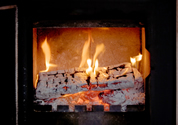
07 Jul Wood Fires
DID YOU KNOW
Gas appliances should be serviced annually by a qualified gas fitter to ensure they don’t release toxic gases into the home.
Wood combustion fire places and stoves release a plethora of noxious agents including carbon monoxide, nitrogen oxides, cancer causing chemicals (polyaromatic hydrocarbons) as well as particles like ash and soot. They are known to cause both lung and heart disease especially in third world countries where they are commonly used. These can be ‘back drafted’ into a home from chimneys and flues that are improperly installed, blocked, leaking or damaged. In some cases, this could be fatal. PAHs are a complex class of organic compounds that contain rings of carbon and hydrogen atoms, that are released into the atmosphere during the incomplete combustion of organic matter with most occurring from domestic heating during winter. Other sources include waste burning, motor vehicle exhaust, cigarette smoke and asphalt road and roofing operations. Many of them are known or suspected to be carcinogens. Long term exposure may lead to lung cancer, depressed immune function and respiratory problems (Environment Australia, 2001). There are no NHMRC or WHO goals for PAHs. Measurements taken in eight clubs and five hotels in Sydney, where people were smoking, found PAH levels of 19-131 µg/m3 in clubs and 22-75 µg/m3 in hotels (Cummings, 1991). These levels are significantly higher than levels measured in ambient air in Sydney.
Testing Your Home
Air testing is a complicated procedure that requires a thorough knowledge of the sources of potential gases in and around the building, an understanding of the current exposure standards, and the use of highly technical and expensive equipment. A building biologist will test your home for noxious gases and ultrafine particles and provide you with advice to reduce your exposure levels. For details, click here.
Solutions
- Promote passive ventilation. Open windows and doors when gas appliances and wood heaters are in use.
- Ensure the exhaust fan is on when cooking.
- In relation to a wood heater, burn only well dried seasoned wood; ensure the flue is open and kept clear of obstruction.
- A licensed plumber or gas fitter should install, service and maintain a wood heater on a yearly basis.
Want to Learn More?
Courses:
